How to Make and Use Eric Krewson’s Tillering Gizmo
Some time ago I wrote an in-depth build-along entitled the “Beginner’s Guide to Building a Hickory Longbow.” Well, in researching how to build a selfbow it is impossible not to hear about Eric Krewson’s tillering gizmo. As such, I felt it would be natural for me to reach out to Eric and see if he’d be okay with me sharing some of his secrets. Not only was he happy to share the information, he generously sent me a tillering gizmo as well.

This information has been republished with the permission of Mr. Eric Krewson.
By Eric Krewson
Since I made my initial tillering gizmo there has been an input of ideas to make it work better from other bow makers. Consequently, it has evolved into a differently made tool than my original design.
Here is how to make the latest version. I use a drill press, bandsaw, and belt sander (because I have them). This tool can be made out of any scrap wood, holes drilled by hand, out of square and work just fine.
I cut a large downed cedar looking for a bow stave. I may or may not have found a stave, but I definitely found a bunch of beautifully grained gizmo material.
I start by cutting a piece of wood 1″ square and 6″ long. You can make the gizmo longer if you want to, but I have tried a bunch of lengths and always come back to 6″.

A little sanding to get rid of the saw marks.

Mark the center of the block lengthwise and center.

Drill a 5/16″ hole on the center mark.
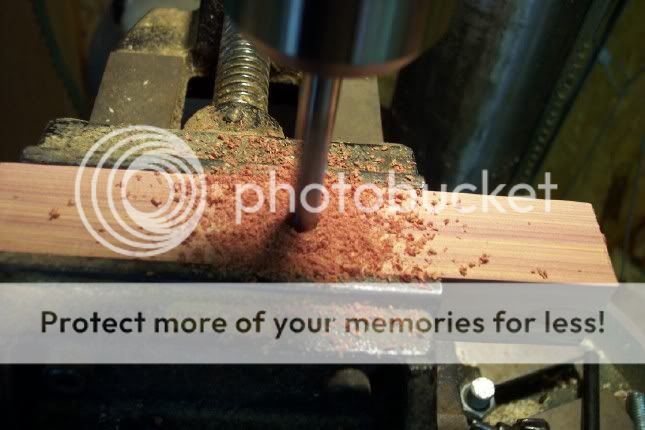
Use a 1/2″ Forstner bit to cut a 1/2′ deep hole over the 5/16′ hole you just cut. The Forstner bit cuts a clean hole, but any 1/2″ bit will work just fine.

Next, mark the ends of the block with a 45-degree angle to shorten side opposite the pencil of the gizmo. This allows one to run the gizmo closer to the tips while tillering.

Here is and update for a slimmer shape for your gizmo that will go further up the limbs without string interference.
I tap a 5/16″ nut into the 1/2″ hole and seat it all the way down with a piece of dowel.
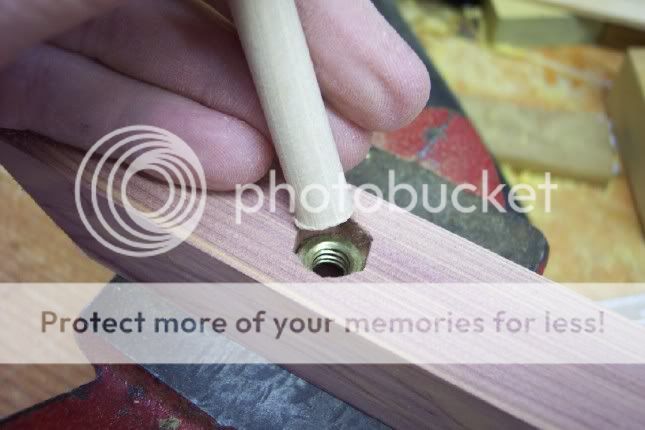
Screw a pencil into the nut(I put the pencil in a vise and screw the gizmo on it) and you are ready to tiller. I sand the pencil a little after I cut thread on it so it will screw in and out easily. It only took me 10 minutes to make this tool, start to finish.
With a little Tru-Oil this will be a beautiful little tool, it has a wonderful grain pattern.
Older version:
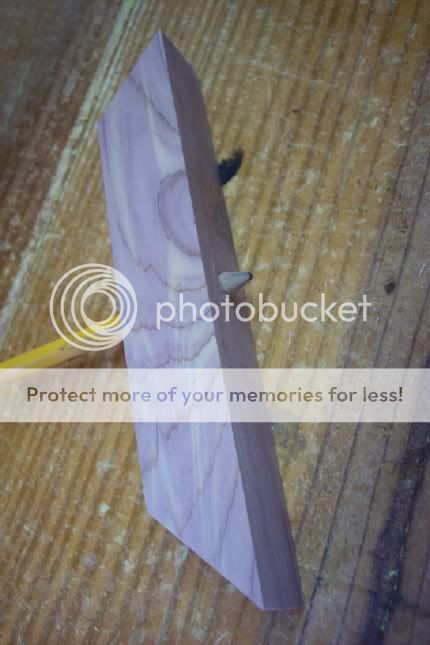
Newest version:
USING THE TILLERING GIZMO
After floor tillering your bow, bend the bow slightly on your tillering tree or tillering stick using the long string. Retract the pencil in the Gizmo and run the wood block up the bow’s belly and find the widest gap. Screw the pencil in the block to a point it is almost touching the bow’s belly at the point where you found the widest gap. I change the angle the pencil has been sharpened to a very short angle and sand the tip of the pencil flat for the best results in marking the limb. This lets you work very slight bends.

Initially, I set my gizmo pencil about 1/8” off the limb for the first few corrections. This course setting will mark only the stiffest spots. If you set the pencil too closely for your first few passes it will mark the whole limb.
Run the Gizmo up the belly making sure it is centered on the limb. The pencil will mark non-bending areas, which need wood removed. Always check the entire limb with the gizmo every time you use it and scrape wood from all the stiff spots at the same time, not one stiff spot at a time. Start on the long string, continue at brace and up to about 20” of draw. You do need to have a way to hold your bow string while you mark the limbs with the Gizmo.
I often set my gizmo for one limb and use this setting on the opposite limb as well. This way you will end up with two closely matched limbs.
I have holes in my tillering tree and insert a 3” piece of dowel in one of the holes to hold the string with the limbs slightly bent while I mark the limbs with the gizmo.

Go slowly, no more than ten scrapes on the marked areas of the limb, flex the limb 30 times and recheck. I have found it usually takes five or more check, scrape and check sessions to get a stiff spot moving, so be patient. You can get the limb bending perfectly this way. You will still have to eyeball bending in the fades, but the rest of the limb will be perfectly tillered. Hinges will be a thing of the past.
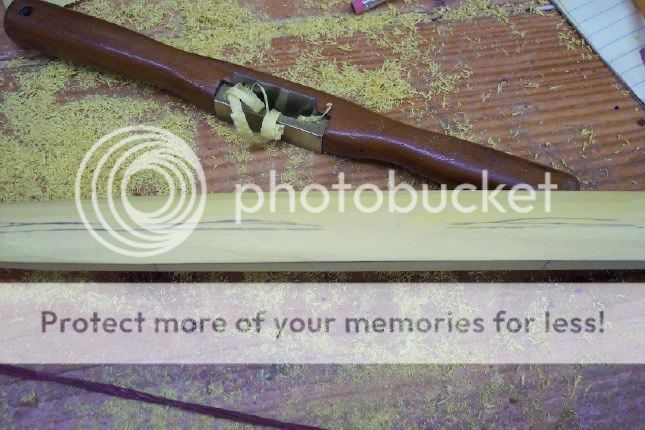
Make a few passes with the gizmo on your limb and the areas that need attention will be perfectly obvious. You can fine tune the tillering by closing the gap between the pencil and limb to almost nothing. At this point, I like to use a cheap orbital sander to remove both wood and any tool marks that are left. With course sand paper, the sander will leave tiny swirls in the wood so I like 220 grit for my final tillering work with the sander and follow with a light hand sanding.
The gizmo doesn’t work in the fade out area of the riser so you will have to eyeball the bend in this area or put a flat board across the back of the bow in your tillering tree and watch the gap between the back of the bow and the board to see where the limb is bending.
Tillering that once took me hours to get close takes me about 45 minutes with the Gizmo and the end result is close to perfect.
The key thing to remember for proper tillering is using a scraper or sandpaper and work slowly, only scrape off your pencil marks, flex the bow and recheck. I often make a zig-zag pencil mark from one side of the limb to the other over the gizmo’s pencil mark to make sure I remove equally from one edge of the limb to the other.
If you ever get the urge to grab a course rasp or use a belt sander to speed things up even more, take a coffee break and come back when these thoughts have passed.
Question
What about using this with character bows, especially yew that has rollercoasters rather than snakes?
Answer
The gizmo won’t work with a stave with a lot roller coaster (a limb with a lot of dips and humps). I almost always take the roller coaster out of my osage before I start a bow, because it is such a pain to tiller. If the roller coaster is only in one place in the limb I eyeball that section and use the gizmo on the rest.
Question
Eric, are you sanding down the nut side once things are finished so it’s sitting flush? or is it still recessed in the finished gizmo?
Answer
I drill the big hole deep enough to tap the nut about 1/4″ below the surface of the wood. I drilled a shallower hole on the earlier version and sanded the wood and nut flush but often lost too many threads of the nut in the process. The new version with the recessed nut works much better.
This nut is in a little over 1/4″ deep.
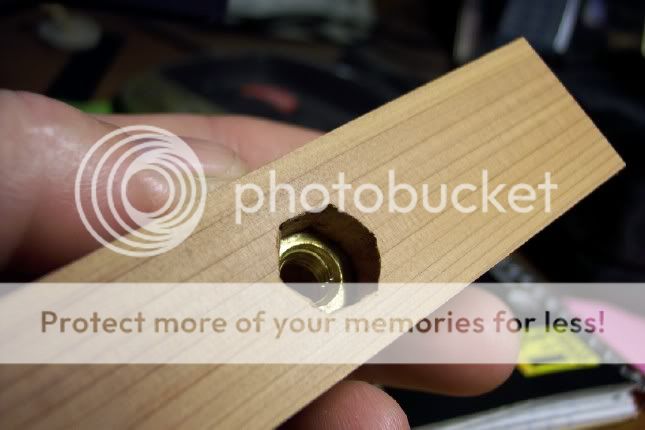
















.jpg)
